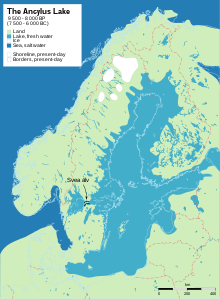|
Maglemosian culture
Maglemosian (c. 9000 – c. 6000 BC) is the name given to a culture of the early Mesolithic period in Northern Europe. In Scandinavia, the culture was succeeded by the Kongemose culture. Environment and locationThe name originates from the Danish archeological site Maglemose, situated near Gørlev and Høng on western Zealand, southwest of lake Tissø. Here the first settlement of the culture was excavated in 1900, by George Sarauw.[1] During the following century a long series of similar settlements were excavated from England to Poland and from Skåne in Sweden to northern France. When the Maglemosian culture flourished, sea levels were much lower than now and what is now mainland Europe and Scandinavia were linked with Britain. The cultural period overlaps the end of the last ice age,[2] when the ice retreated and the glaciers melted. It was a long process and sea levels in Northern Europe did not reach current levels until almost 6000 BC, by which time they had inundated large territories previously inhabited by Maglemosian people. Therefore, there is hope that the emerging discipline of underwater archaeology may reveal interesting findings related to the Maglemosian culture in the future. CharacteristicsThe Maglemosian people lived in forest and wetland environments, using fishing and hunting tools made from wood, bone, and flint microliths. It appears that they had domesticated the dog.[3] Some may have lived settled lives, but most were nomadic.[citation needed] Huts made of bark have been preserved, in addition to tools made of flint, bone, and horn. A characteristic feature of the culture is the sharply edged microliths of flintstone, used for spear and arrow heads.[4] Another notable feature is the leister, a characteristic type of fishing spear, used for gigging. Scandinavian data table
Genetics
See also
References
Sources
Danish-language texts
|
|||||||||||||||||||||||||||||||||||||||||||||||||
